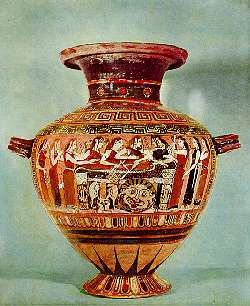2. Achilles' chant
Menin aeide, thea: ever since the Iliad's
famous incipit was transmitted through individual readings
(and not collective listening), written word (and not voices,
sounds and gestures), in silence (not aloud), via the eyes (not
the lips, the throat and the entire body), the sound events and
the means of transmission included in it have undergone a slow
process of desonorization, becoming suppressed in the silent
commentary. Yet, for at least a millennium (about ten centuries
separate the Homeric epoch from that of the Antonines), the
comments, notations, interpretations, and references to the first
three words retained the memory of the music and its strong
association with ways of learning, preserving, and transmitting
the myth. Frontisi-Ducroux maintains that the
written text is rich of "discreet effects" that are
actual traces of the primitive oral character of the epic poem.
Such traces not only ensure even today the contact between the
poet and his audience, but also enable the listener or reader to
imperceptibly take part in the poetic construction (1986). This
thesis leads us from the very start to consider the action and
narration in terms of a useful critical estrangement.
From its very first word, menin (rage), the Iliad
evokes a sound event, or rather a series of connected sound
events, each of them containing an element in common with other
moments of the mythological continuum in which the teaching,
transmission and reception of music take place. Each small piece
of the mosaic recalled at least another piece - and usually more
than one - from which it was easy to pass on to a new piece and
then to another, through literary forms that became modified in
time also with reference to the different poetics of individual
authors. The sound event described here is one of the most famous
tesserae composing the mosaic of the mythology of sound in
Homeric and archaic Greece.
Far from the noise of the military encampments and their
strategic intrigues, on the seashore, Achilles
had found an alternative to war that was able to satisfy his
proud heart.
 Achilles'
funeral.
Paris, Musée du Louvre, E 643
Corynthian hydria from Cerveteri.
|
An expert both in the art of war and in accompanying
songs on a string instrument (Avezzù-Ciani 1994), he
abandoned the former. His soul found a balanced
compensation in singing the deeds of other heroes to the
sound of the phorminx (Homeric chord instrument),
while Patroclus, the silent audience, listened at a
distance (Hom. Iliad
IX.186-189). Central to the sound event are the
modifications of the feelings and actions produced by the
sound of the instrument, whose "identity" is
established, not only by its shape and number of strings,
but above all by its precious decorations which allowed
one to recognize its previous players. Achilles knew very
well its worth, and did not abandon it even to stand up
and converse with Odysseus: because of its fine carving
and silver bridge, he had easily singled it out, and
placed among the rich spoils taken from one of the cities
on which Eëtion reigned. The phorminx is regarded
as an object of reward, a geras that is worth the
hard-fought battle, like the iron disk (Hom. Il.
XXIII.826-829), the horse Pegasus (Hom. Il.
XVI.152-154) or Briseis herself (Hom. Il.
II.688-691, XIX.58). |
Later on, in the effort of ordering systematically the mythe
in the mythologique (Vernant 1996), that phorminx,
having become a lyra, shall be known as the gift of
Hermes to Cadmus on the day of his marriage to Harmony, a fact
that is well known to all listeners (Diod.
Sic. V.49; Rocchi 1980). The phorminx that was
able to delight the heart of Achilles (terpomenon ... eterpen
/ "giving delight ... gave delight") was unique in
that it embodied the "magic sediment" (Leydi 1991) of
the god to whom it had originally belonged, in a context of
mythological cross-references. On the one hand, such a context
lends truth to the characteristics that are peculiar to the sound
object; while, on the other hand, it refers the object back to
other parallel events, through the identity or affinity of
places, the homogeneity of contexts, and the presence of
divinities with sound characterizations, in a system which
remains open-ended. In this case, the connected events could be
the marriage of Thetis and Peleus (Pindar, Pyth.
3, 89-92), celebrated in Thebes - a city of music
and sound ever since its mythical foundation - during which the
Muses sang; however, it can also evoke the relationship linking
Achilles and Chiron (ps.-Plut. Mus.
1145e-1146a). Instead of the Muses' "gift" to
the aedo (Gernet 1948) - that is, the ability to sing the klea
andron thanks to the memory of what is, what has been and
what will be (Hom. Il.
IX.189) - in this relationship we find the model of the
direct learning process between teacher and pupil, extended to
incorporate a wealth of magical practices that included sound
together with healing remedies (pharmaka) and weapons. Through his teaching the
Centaur accomplished visible and long-lasting transformations in
both the body and the soul in the context of a pre-Homeric
society of nomadic hunters and shepherds.
Achilles' chant is a paradigmatic example of a "mythical
sound event", i.e., it is a narrative that includes among
its protagonists at least one mythical character - not
necessarily a musician - and that evokes some kind of sound
event, taken in the broadest sense - e.g., a shouting or singing
voice; musical instruments; imagined or prohibited or played
music; divine and human performers; music teachers and their
pupils. Each component of the narrative branches off into
mythical/musical ramifications; these, in turn, intersect to
create centrifugal or centripetal motions that both begin and
terminate in the initial sound event, giving rise to narrative
variations and developments.
Forward | Main page | References
